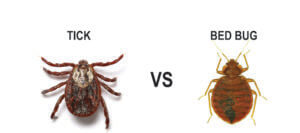Differences between Ticks and Bed Bugs
Though they look similar at a glance, there are several ways to tell the difference between ticks vs. bed bugs. Upon closer inspection, you may recognize some key markers in appearance, behavior, and habitat. It’s important that you know which one you have due to the potential health risks each can cause.
Appearance

Both pests have flat, brownish bodies that expand after they eat. During a tick’s nymphal stage, it can closely resemble an adult bed bug. However, unlike bed bugs, ticks are not insects. These pests have eight legs, which makes them arachnids.
Habitat
Hikers, groundkeepers, and children playing in tall grassy fields may encounter ticks. These pests might also hide in brushy areas or leaf litter, so homeowners need to use caution when doing lawn work. They attach themselves to humans and animals, but the host may not notice its presence right away.
Alternatively, bed bugs can enter homes on secondhand furniture, clothing, and bed or bath linens. Travelers can also bring back bed bugs in their luggage if they stay in a hotel with an infestation. Bed bugs prefer human blood, unlike ticks, which will feed on wildlife, people, and pets.
Health Risks
Ticks and bed bugs are most active during the warmer seasons in the Mid-Atlantic, increasing the risk to residents during this time. Bed bug bites produce irritation, itching, and burning near the site, though the pests do not spread disease. Ticks, however, can transmit several pathogens that can cause Lyme disease, Rocky Mountain spotted fever, and babesiosis.
Once inside, these pests can go undetected for some time. You should take action as soon as you suspect an infestation. If you believe you have ticks or bed bugs, call our team of professionals at Western Pest Services.